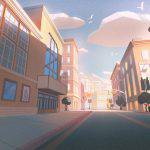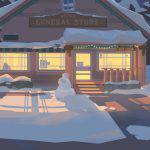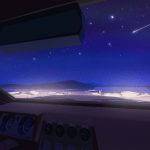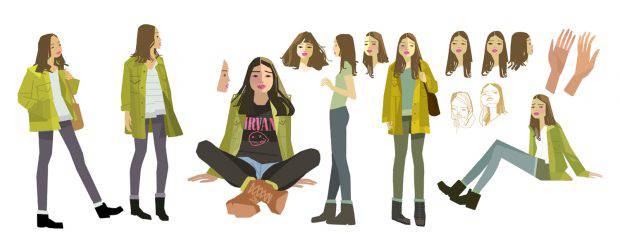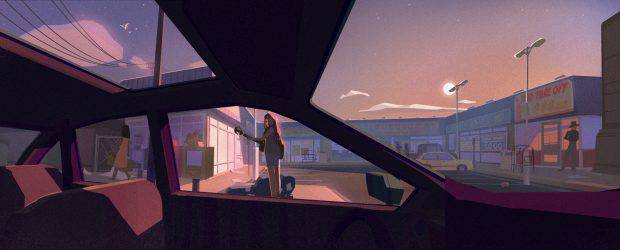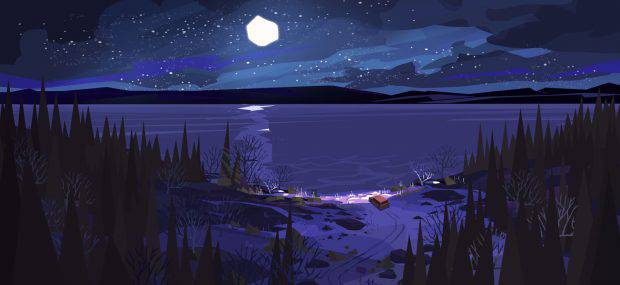Patrick Osborne discusses ‘Pearl’ (Google Spotlight Stories)
Google ATAP have recently released the latest project in their Spotlight Stories series, Pearl. Pairing up with Patrick Osborne, the Academy Award®-winning director of Disney’s Feast, the ATAP team have created another immensely watchable, immersive storytelling experience following on from previous entries such as Glen Keane’s Duet, Shannon Tindle’s On Ice and Tim Ruffle/Aardman’s Special Delivery. As with other films in the series, the viewer is placed in the midst of the action and can observe the story play out around them. For this music-oriented entry Patrick has succeeded in incorporating jump-cuts, a potentially-jarring filmic device that, in its execution, works very effectively from the viewer’s vantage point. In Pearl we are an unseen ‘passenger’ observing the life and times of a single father and his daughter traveling across the country, to tell a story ‘about the gifts we hand down, their power to carry love…and finding grace in the unlikeliest of places’. Boasting the most shots, sets and characters as well as interactive sound and custom lighting, Pearl stands out as being the most technologically complex Spotlight Story to date.
Skwigly were eager to catch up with Patrick and learn more about the work that went into the project, in anticipation of Pearl‘s Annecy Festival presentation next week.
Following the huge success of your Disney short Feast, how did you come to be involved with Google ATAP?
I met (Creative Director) Jan Pinkova and (Executive Producer) Karen Dufilho at Annecy, probably the day before or after I met you guys. They go to Annecy every year, I’m going again this year in the week to show Pearl and also to see all the other animated stuff. It’s kinda neat to meet all the different animation people in the world. It was just sort of like a lunch where I met them, but we talked about Glen Keane’s Duet that was just on its way out then, and they had a version on the phone that was really cool, so I thought it’d be neat to experiment in this world.
I’d always thought it’d be cool to have a career out of making shorts, but it didn’t seem possible, it didn’t seem like a financially viable world really. Anytime there’s kind of an explosion in technology or a new way of looking at things there’s an opportunity to make creative stuff with that technology and it was neat to see that they were trying to do that. I knew the VR headset world was just around the corner and we might be able to do it for that too, so it started with meeting at Annecy and then again at CTN Expo where we went through a couple of ideas that I could possibly do. It wasn’t until I actually decided to leave Disney that I actually jumped on. That was when the decision happened, after I’d decided to take off from the studio and try to make it out there as an independent, that I wanted to take on a couple projects that were fresh and felt like there was a challenge to them.
Had there not been a potential project like this do you think you might have stayed on at Disney?
Well, when you work at a big studio you can’t really pitch original stuff around the world, to other places. Disney’s a wonderful place, there’s a lot of great directors there that are ahead of me as far as clout and ability, really, and the line to do a feature there is quite long considering they only make one movie a year. So I decided that it would be best for me to go out on my own and see what it was like while I had the opportunity, because the opportunity doesn’t stay around forever; you kind of fade off.
So since then I’ve been pitching stuff around. With Google it’s a one-project thing, it’s not exclusive so I can continue working on getting other stuff off the ground, and that was the advantage to jumping out and doing something like this, that you can get a foothold in the industry itself as an independent creator and start making things that way.
- Pearl concept painting by Tuna Bora
- Pearl concept painting by Tuna Bora
- Pearl concept painting by Tuna Bora
- Pearl concept painting by Tuna Bora
When you began were you set any kind of brief or parameters to work within, or was the idea something you had pretty much had free reign with?
There weren’t really a lot of parameters other than it would use the mobile platform in some way, so if it was gonna be 3D it had to be simple enough in its design that it could render in real time, on a mobile device. Which I don’t mind, I think simplicity in design is a fun constraint. It was worth it sometimes, to give yourself a limitation that’s pretty difficult, to see if you can do it, so I thought that was pretty cool. There wasn’t a literal time length, but in my mind there’s a five-or-six minute limit for this kind of thing, especially for how long someone will hold up their phone. In the VR space I think the amount of time you can spend in the world is a lot longer now, it’s a lot more comfortable to turn your head around than to hold a phone up. But I think those were the only constraints. I wanted to do something that had edits in it, that felt cinematic and that it had a real sense of place, and my cheat was to put it in a car the whole time, as a way to give you, as the viewer, a sense of space so you know which way is front and back but you can still cut weather, time of day, all that kind of stuff, to make a film that happens over time and not disorient the viewer.
So it started there, then had the idea of Well, what if it’s like that Shel Silverstein Giving Tree story? Kind of inspired by the idea of using up an object but passing it on. Then you start to think about character and a story comes out of that, and it ended up being about passing on not only an object, a car, but also a talent, a passion or interest. So it kind of builds from a technical requirement and a desire to do something cinematically with this format and then it grew from there.
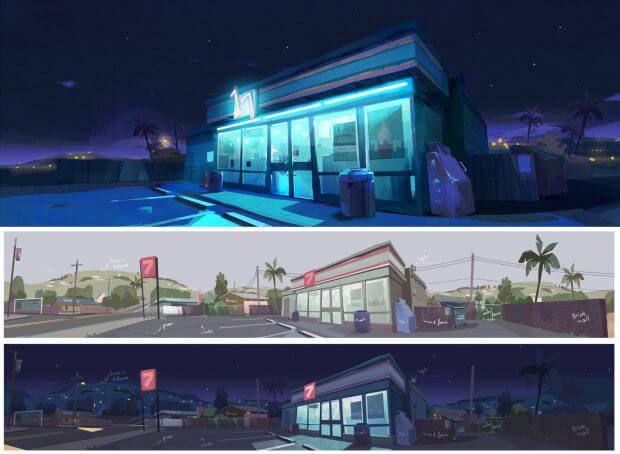
Pearl concept painting and set design by Aymeric Kevin
The music angle is a major part of the film, sort of similar to Feast considering that was very music-driven and dialogue-free, though in this case the song serves as a binding part of the story. Is music a passion of yours or is it more an analogy?
I’m into the indie folk scene, I try to go to South by Southwest every year and see music there, and I thought it would be really cool to take this hi-tech stuff, this new VR, 360 thing and combine it with something that was kind of folkey to create a nice juxtaposition of ideas. Then the actual structure of the film is the same as a pop song; I feel that’s a fairly recognizable structure, people get the verse/chorus nature of pop songs. You always want some kind of structure to hang your story on, it just makes you understand it better, and I thought a pop song structure would be interesting and cool to do in a short film.
It made it a little bit difficult, the story is variable in length if you watch it on the app or VR because it’s a game engine, it will wait for you if you’re not looking at the right place or in the right direction. So the song itself makes that more difficult because the it’s timed and the characters move to the music in a particular way, so you only have a few moments where you can really mess with that.
Is that also the case with the YouTube version?
Yes, if you’re watching on an Android phone. YouTube has a game engine built into it for the Spotlight Stories, where it’s not actually playing a video, it’s rendering real-time on the phone and streaming on android devices. That doesn’t work on the iPhone but the iPhone has the free app download instead that does that. So there’s a version on each type of device that you can watch, but it requires a pretty strong phone to do it!

Pearl character designs by Tuna Bora, Oren Haskins, Meg Park, Willie Real & John Nevarez
We’re definitely looking forward to experiencing the film in the more fully-immersive environment when it’s presented at Annecy, although I do feel that it’s quite nice the way YouTube have incorporated that ability to look around, even if you’re just watching it in a browser.
Yeah, it’s definitely not the best, I think when you’re in the HTC Vive version you can stand up and look out the sunroof, or stick your head out the window if you want, so there’s something pretty cool about that more immersive version of the story, I think.
Just in terms of the planning of the story, because of how many considerations there has to be, is it traditionally storyboarded out, or do you have to adapt that stage of the process to accommodate all of the things that are going on?
There’s no real tool to make storyboarding easy for this kind of stuff, because you don’t really have a way to draw, you want a sphere around you that you’re drawing on. VR tools will develop soon to wear the headset itself while making stuff, I know a couple of the engines are starting to make that, there’s Tilt Brush, a drawing tool for 3D, there’s a lot of stuff happening in that area. For me, I boarded it out but it was only like an emotional board of ‘moments’ that happen and how they string together, it wasn’t like a finished thing, you never really got that until it was done.
So we did a board for the story beats, but it was not dimensionally accurate, so then we did a 3D layout with characters as blocks of colour, this actually was in 3D, so you could get a sense of the space but then the acting isn’t there. So you’d have to mix the two in your head. There’s a lot of faith required, we didn’t really know that it worked until about a month ago when it was all strung together! We finished doing all the creative stuff in November but it took another four months to optimize it so it ran fast enough to actually watch. That’s a tough thing to do, to have an idea and put it together and not be able to see a finished work for that long.
Have you seen other ATAP projects during the development of it?
Yeah, I was in the office at ATAP. It’s a really cool little warehouse, they’re working on all kinds of crazy stuff, just way out there and really exciting and very different than the stuff that we were working on. So I saw that and the other Spotlight Stories that were being made too, I liked that they were all pretty different,none of them felt like any other one, they were all taking their own approach to everything.
From your perspective, seeing these different projects and considering your own experience, do your feel there’s a firm future for this marriage of VR and storytelling?
A lot of stuff you see right now is very demo-ey, very simple game mechanics that people are introducing and playing with. There is a hype behind it right now, for sure, because there’s funding and a lot of companies are wanting to jump on board while it’s available. The real test will be how many people actually get it in their houses. For the Vive and the Oculus it’s pretty tough because they’re expensive and require an incredible computer, I think the Playstation version of it is going to be more widespread because it’s less expensive and a lot of people already have a PS4. Then there’s the mobile side of it too which doesn’t have some of the cool parts of the higher-end ‘workhorse’ versions, but they’re still kind of interesting. I have a Vive in my house and it’s really fun, everything that comes out I wanna watch because there’s something new and interesting about that and I think that’s kind of cool. The hype is not going to last forever but if someone makes something amazing I think it will stick around.
Creatively what would you ideally like to be working on after this?
Well, I’m always just into doing things that feel like a challenge, that are interesting and different, things I haven’t done. With everything I do I try to jump with all of my effort into situations that are different to what I’m used to, where I’m learning a lot. So I’m working on a couple features, I like them because the stories seem vital, and ‘now’, and interesting to tell. I jumped on board as the producer of a TV show because I’ve never done that and I’m fascinated as to how that all works. I’m interesting in being involved in something like that at a pace that comedy television works, to be working with writers that are of the caliber that we are working, and to learn.
The Annecy Festival event Google Spotlight Stories: Once upon a time in 360 takes place on Monday June 13th 6pm at the Salle Pierre Lamy, featuring Patrick Osborne alongside fellow Spotlight Story creators Felix Massie, Chris o’Reilly (Rain or Shine, Nexus Productions), Peter Lord and Tim Ruffle (Special Delivery, Aardman).
Festivalgoers can experience Pearl firsthand at the Bonlieu’s “salle de création” on Tuesday 14th from 10am-5pm.
You can learn more about Google Spotlight Stories visit the official site.
See more from director Patrick Osborne at bighappyaccident.com



